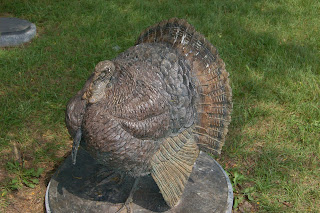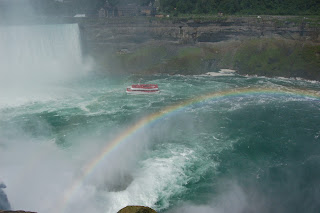We arrived at Fillmore Glen State Park near Moravia, New York on Tuesday for our stay during the wedding of my daughter Stacy and her partner Ruth Ann. Ruth Ann's family is from the area around Skaneateles Lake. They have a complex right on the lake that can accommodate 20 or more people. On Thursday ten of us got together for a ride on the Judge Ben Wiles, the local tour boat.
The boat takes you on a cruise down the lake for a mile or so then crosses the lake for the return trip.
This shot is moving away from the dock looking back at the town. There is a thriving lake front with a lot of shops and eating places. This lake is 16 miles long and 300 feet deep. These so called finger lakes were formed during the ice age. When the glacier receded it left the lakes behind.
Then we started to pass lake front homes of the rich and famous.
The tour guide told us the names of a lot of the owners of which I can't remember. There were a lot of CEO's of large companies mentioned as owners. One of the homes under construction was owned by Derek Jeter.
The country club on the lake
This is the boat house. for the house in the pic below.
Friday began the set-up for the wedding. The girls had rented the barn used by the locals for large gatherings. It is a very large that can accomadate 100 plus guest.
Ruth Ann on the left my niece Kristy on right.
The wedding party gathering for our instuctions
The barn all ready for the big event.
The day of the wedding it started to rain. Ruth Ann with her brother Chip in the lead with Stacy and me following. I will post more pics of the wedding when I get them. We were ask not to take pictures during the ceremony by the photographer.
Monday Louise and I headed up to Auburn to play pickleball in the morning. We had played there Wednesday morning and had a great time so we returned for another round of games. Tuesday we were off with Stacy, Ruth Ann and some of her family to Rochester, New York to visit the Eastman
Estate. This was the home of George Eastman the founder of the Eastman Kodak company.
"In 1902, George Eastman purchased the last 8.5 acres of the Marvin Culver Farm on East Avenue in Rochester for his new Georgian Revival style mansion. Assisted by landscape architect Alling Stephen DeForest and architects J. Foster Warner and William Rutherford Mead, Eastman transformed the farmland into a unique urban estate that functioned both as a working farm and as an elegant floral setting for entertaining. In 1916, Eastman purchased four additional acres and hired DeForest to draw another plan of the property in 1921. The resulting landscape provided the finishing touches, tailored to Eastman’s needs as well as his character. In addition to spacious lawns, eight flower gardens, and five greenhouses, the estate also featured an orchard, a poultry yard, stables, pastures, a rolling east vista, and a magnificent house. In this way, Eastman was able to enjoy the benefits of life in the country without even leaving the city."
Anyone that knows me knows that iron work is my passion. These grills were made by Samuel Yellen, the most prominent blacksmith of the era. They were magnificent works of art.
The west side of the house
We took the tour of the gardens
The east side
More ironwork. I am not sure if this is a Yellen piece or not, but I think it is. I ask the guide but she could not verify it for me
After leaving the mansion, we headed to the Costco for a few things. It poured rain off and on during the ride back to the campground. Tomorrow is our last day at this campground. We are suppose to go on a hike with the girls in the morning if the rain will stop long enough.
Till next time
Duane and Louise



















































